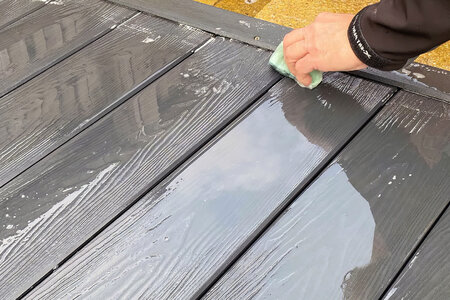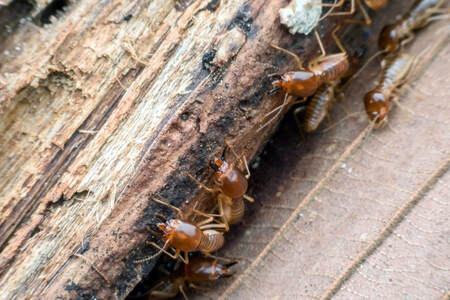
How To Clean And Maintain Composite Decking
Learn how to clean and maintain your composite decking with our guide. Follow our easy steps and tips for a brand new look. Contact Final Touch Carpentry and Constructions for expert help.
Read Full StoryWho doesn’t like to sit on the deck with a beverage to enjoy everything the world offers?
One of the biggest perks of having a timber deck drop is getting a space in the house purely for enjoyment. If you want to call some friends over for a barbecue, host a small birthday or enjoy your morning breakfast in the open, having a deck can be a huge benefit.

A timber deck can become slippery when wet, which can lead to many accidents and even mould formation without proper preparation and care for the deck.
If you are looking for ways to make the wood deck surfaces less slippery, this guide is for you. We have put together some information to assist you in making the deck slip resistant.
Now, without further ado, let’s slide into the essential bits.
Before venturing into the world of anti-slip coating and anti-skid strips, understand the reasons for decking being slippery, let’s look into some of the causes of slippery decking. This will allow you to identify the root cause of the issue and determine if it can be eliminated.
One of the biggest reasons for slippery wood surface is the accumulation of leaves and debris. If you live in a place with heavy winds, there is a chance that the deck will be covered with leaves and debris a few times a year. And with it comes pollen, dirt, and whatnot.
The main issue here is that the moisture in the dirt, leaves and pollen might stay trapped on the deck boards even if you remove them. And as they grow, the moisture on the wood deck surface will also increase. This will make the timber wet and a breeding ground for mould, algae, and moss. It could also cause potential warping.
Algae, mould and moss are Among the most significant reasons the deck doesn’t have a non-slip surface and a hotspot for accidents. No matter what kind of wood is used for decking, they are all susceptible to moisture and ill effects.
After you point out the root cause of slippery boards, the next step is finding out what can be done to prevent it. You’re lucky to have been looking for ways to make the wood deck surface less slippery. Take a look at some of these steps you can incorporate into your everyday life:

The most effective way to prevent slippage on the decks is by conducting a thorough cleaning. On seeing the deck boards with few leaves or debris, most people do not clean them, thinking they will get to it once it’s fully covered. However, that is the first mistake.
Even a few piled-up leaves can trap moisture in the wood. This is why keeping it free from even the smallest mess is essential. Cleaning, or essentially ensuring you clean your deck once daily, should reduce the chances of any wetness remaining on the surface.
Ideally, the best time would be to clean the surface in bright and sunny weather. This will make the cleaning process more manageable, with the leaves not sticking to the deck and the surface drying faster.
Algae, moss and mildew grow in tight spaces where the moisture is trapped. This is why the best way to prevent the formation of any kind is to check the deck thoroughly.
While cleaning the grooved decking is crucial, checking for dirt in these tight spaces and removing any potential buildup of algae or moss is equally important them is good. Thoroughly cleaning the deck will not be possible every day, so doing it once/twice a year is sufficient.
A good deck cleaner solution would ensure every nook and cranny is free from moss, mildew, or algae. Either make the cleaning solution or buy it at the store; either way works well.
Additionally, many deck owners tend to powerwash the deck all the time, which is unnecessary. This can deteriorate the quality of the deck, making it look worn out too soon. Light sweeps every day, and cleaning with solutions and power washing once a year should suffice.
Anti Slip Decking Oil is perfect for your home garden decking and equally good for making decked steps safe. But they’re also excellent anti-slip products for high-traffic commercial decking in places like pubs, cafes, nightclubs, and restaurants. If someone slips on your garden deck at home, it’s unlikely they’ll sue you.
As mentioned, mould, mildew, and moss grow in tight spaces where regular cleaning is impossible. While you can conduct a thorough clean and check once or twice a year, purchasing grooved decking boards is one way to keep every nook and cranny dry.
When laying out the grooved decking boards, ensure a proper drainage system is in place, reducing the chance of trapped moisture. The best way to have a slight gap between the boards is to let the water flow out instead of pooling.
If the boards do not have a gap, they can easily be created by lodging a nail or a knife. This will create an opening for the water to flow out and reduce the chances of a slick, non-slip deck.
Now that we have gone over how to prevent a wooden deck from becoming slippery let’s find ways to fix it. If you are at that stage where the deck has already become slippery, these tips might come in handy.

One of the best ways to remove the slickness on the deck is by scrubbing it. You can use ammonia-free powdered laundry detergent, oxy-bleach, and water to create a powerful cleaning solution. You must add a detergent cup with bleach and mix it with two to three gallons of water.
It would be best to coated the entire deck with the solution for this to work. You may use a mop or pour it on the surface and let it be there for 30 minutes. The chemical in the ingredient will break down everything on the surface, making it easier to scrub.
Another popular way of getting rid of and preventing a deck from becoming slippery is by using anti-slip paint. Anti-slip paint is quite easily found in the market, and a generous coating can make the deck slip-resistant.
Additionally, you can use these paints on top of any wood painted or stained. This is mainly because the deck stain or paint does not connect the wood, making it slippery. Adding a coat of non-slip paint will make the wood decking slip-resistant for longer.
Applying this non-slip paint is quite simple, too. The first and most crucial step is washing and drying the deck. Once it has thoroughly dried, use any appropriate paintbrush and apply a generous coat of paint. If it is easier, you can use a roller as well.
Once it has been fully applied and dried, you will notice some resistance from the surface. It makes decking non-slip, making it more resistant to leaves and debris.
If you do not have the time to create a solution, rush to the nearest store and buy a moss and mildew killer. These solutions are easily found anywhere and can target everything, including algae.
The ready-made solutions make deck cleaning easy as the effort to create a cleaner is eliminated. Additionally, the process remains unchanged and can be effortless, depending on the solution used.
While there are many in the market, some eliminate the scrubbing process. It would help to let the solution sit and then rinse it with water. The chemical breaks down the algae, moss, mildew and mould quickly.
opting for smooth decking may not be a viable option for everyone, and rubber mats might provide a good alternative. This is where adding sand to the stain comes into the picture. A great way to create non-slip decking is by adding sand to the stain while the stain is wet.
However, it is not as easy as dumping sand into the stain. One crucial point is that the sand must be even, so use the right tools. The best way to do this is to use a spreader for an even coat of sand after applying the stain while it is wet.
Now, non-slip strips may be a little controversial in changing the deck’s look. However, one of the best ways to ensure the decking boards offer ample grip is to pressure wash them regularly. The process of installing them is much more straightforward than painting and scrubbing.
It is worth noting that while you will get non-slip decking, these strips are raised when installed right. Hence, you must be careful when applying these on the stairs. Additionally, you will need to hammer them in, which does not take much time.

We finally reached the end of our guide on creating an anti-slip decking. There are many more ways to go about this, like using a pressure washer or anti-slip tape, but the ones mentioned are easier and can be done by anyone.
Contact us if you live in Sydney for professional assistance in ensuring your timber deck is slip-resistant! We will provide you with a free quote and upfront pricing.
On that note, we shall sign off. See you soon with many more guides.
Until next time!
Learn how to clean and maintain your composite decking with our guide. Follow our easy steps and tips for a brand new look. Contact Final Touch Carpentry and Constructions for expert help.
Read Full StoryAre you wondering whether to choose timber or steel for your decking support? Let us help you out make the right choice with our guide to deck supports.
Read Full StoryLooking for ways to protect your decking from termite colonies? We’ve got you covered with our guide. Final Touch cover everything you need to know about termites and your timber deck.
Read Full Story

